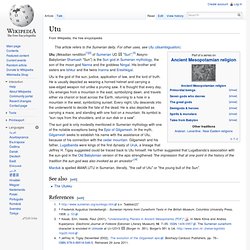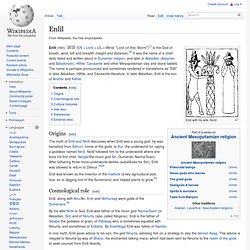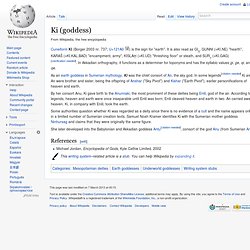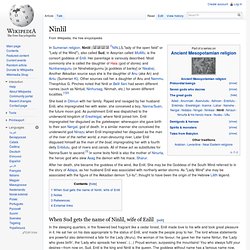

Utu. Utu is the god of the sun, justice, application of law, and the lord of truth.

He is usually depicted as wearing a horned helmet and carrying a saw-edged weapon not unlike a pruning saw. It is thought that every day, Utu emerges from a mountain in the east, symbolizing dawn, and travels either via chariot or boat across the Earth, returning to a hole in a mountain in the west, symbolizing sunset. Every night, Utu descends into the underworld to decide the fate of the dead. He is also depicted as carrying a mace, and standing with one foot on a mountain. Its symbol is "sun rays from the shoulders, and or sun disk or a saw". Enlil. Enlil with his wife, Ninlil Origins[edit]

Ki (goddess) Cuneiform KI (Borger 2003 nr. 737; U+121A0 𒆠) is the sign for "earth".

It is also read as GI5, GUNNI (=KI.NE) "hearth", KARAŠ (=KI.KAL.BAD) "encampment, army", KISLAḪ (=KI.UD) "threshing floor" or steath, and SUR7 (=KI.GAG)[clarification needed]. In Akkadian orthography, it functions as a determiner for toponyms and has the syllabic values gi, ge, qi, and qe. Ningal. Ninurta. Ninurta (Nin Ur: God of War) in Sumerian and the Akkadian mythology of Assyria and Babylonia, was the god of Lagash, identified with Ningirsu with whom he may always have been identified.

In older transliteration the name is rendered Ninib and Ninip, and in early commentary he was sometimes portrayed as a solar deity. A number of scholars have suggested that either the god Ninurta or the Assyrian king bearing his name (Tukulti-Ninurta I) was the inspiration for the Biblical character Nimrod.[1] Cults[edit] Ninlil. After her death, she became the goddess of the wind, like Enlil.

She may be the Goddess of the South Wind referred to in the story of Adapa, as her husband Enlil was associated with northerly winter storms. As "Lady Wind" she may be associated with the figure of the Akkadian demon "Lil-itu", thought to have been the origin of the Hebrew Lilith legend. When Sud gets the name of Ninlil, wife of Enlil[edit] In the sleeping quarters, in the flowered bed fragrant like a cedar forest, Enlil made love to his wife and took great pleasure in it.
He sat her on his dais appropriate to the status of Enlil, and made the people pray to her. Notes[edit] Enki. A large number of myths about Enki have been collected from many sites, stretching from Southern Iraq to the Levantine coast.

He figures in the earliest extant cuneiform inscriptions throughout the region and was prominent from the third millennium down to Hellenistic times. Attributes[edit] Anu. In Sumerian mythology, Anu (also An; from Sumerian *An 𒀭 = sky, heaven) was a sky-god, the god of heaven, lord of constellations, king of gods, spirits and demons, and dwelt in the highest heavenly regions.

It was believed that he had the power to judge those who had committed crimes, and that he had created the stars as soldiers to destroy the wicked. His attribute was the royal tiara. His attendant and minister of state was the god Ilabrat. Sumerian religion[edit] Ur III Sumerian cuneiform for An(and determinative sign for deities see: DINGIR) Anu existed in Sumerian cosmogony as a dome that covered the flat earth; Outside of this dome was the primordial body of water known as Tiamat (not to be confused with the subterranean Abzu).[1] Inanna. Inanna (/ɪˈnænə/ or /ɪˈnɑːnə/; Cuneiform: 𒀭𒈹 DMUŠ3; Sumerian: Inanna; Akkadian: Ištar; Unicode: U+12239) is the Sumerian goddess of love, fertility, and warfare, and goddess of the E-Anna temple at the city of Uruk, her main centre.

Part of the front of Inanna's temple from Uruk Origins[edit] Etymology[edit] Inanna's name derives from Lady of Heaven (Sumerian: nin-an-ak). Worship[edit] Sin (mythology) Impression of the cylinder seal of Ḫašḫamer, ensi (governor) of Iškun-Sin ca. 2100 BC.

The seated figure is probably king Ur-Nammu, bestowing the governorship on Ḫašḫamer, who is led before him by a lamma (protective goddess). Sin/Nanna himself is indicated in the form of a crescent. Reconstruction of the Ziggurat of Ur, the main shrine to Nanna, based on the 1939 reconstruction by Leonard Woolley (Ur Excavations vol. V, fig. 1.4) The original meaning of the name Nanna is unknown.
The pre-classical sign LAK-32 later collapses with ŠEŠ (the ideogram for "brother"), and the classical Sumerian spelling is DŠEŠ.KI, with the phonetic reading na-an-na. His wife was Ningal ("Great Lady"), who bore him Utu/Shamash ("Sun") and Inanna/Ishtar (the goddess of the planet Venus). Sin had a beard made of lapis lazuli and rode on a winged bull.